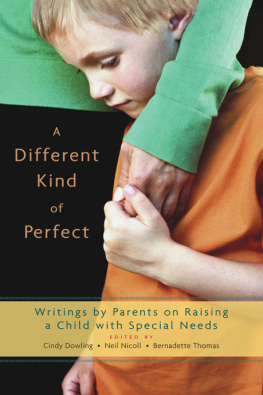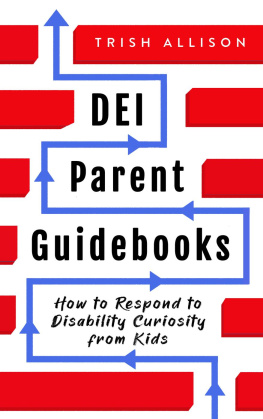Just One of the Kids
A JOHNS HOPKINS PRESS HEALTH BOOK
Just One of the Kids
Raising a Resilient Family
When One of Your Children
Has a Physical Disability
KAY HARRIS KRIEGSMAN, Ph.D., and
SARA PALMER, Ph.D.

Note to the Reader: This book presents general guidelines, information, tips, and tools for raising a resilient family when one of your children has a physical disability. This book is not meant to substitute for advice or treatment from health care providers, educators, vocational counselors, or other professionals who work with your family. The services of a competent professional should be obtained whenever specific advice is needed.
2013 Kay Harris Kriegsman and Sara Palmer
All rights reserved. Published 2013
Printed in the United States of America on acid-free paper
9 8 7 6 5 4 3 2 1
The Johns Hopkins University Press
2715 North Charles Street
Baltimore, Maryland 21218-4363
www.press.jhu.edu
Library of Congress Cataloging-in-Publication Data
Kriegsman, Kay Harris.
Just one of the kids : raising a resilient family when one of your children has a physical disability / Kay Harris Kriegsman, Ph.D., and Sara Palmer, Ph.D.
pages cm
Includes bibliographical references and index.
ISBN 978-1-4214-0930-6 (hardcover : alk. paper) ISBN 1-4214-0930-5 (hardcover : alk. paper) ISBN 978-1-4214-0931-3 (pbk. : alk. paper) ISBN 1-4214-0931-3 (pbk. : alk. paper) ISBN 978-1-4214-0932-0 (electronic) ISBN 1-4214-0932-1 (electronic)
1. Children with disabilitiesFamily relationships. 2. Parents of children with disabilities. I. Palmer, Sara. II. Title.
HQ773.6.K75 2013
649.151dc23 2012035771
A catalog record for this book is available from the British Library.
Special discounts are available for bulk purchases of this book. For more information, please contact Special Sales at 410-516-6936 or specialsales@press.jhu.edu.
The Johns Hopkins University Press uses environmentally friendly book materials, including recycled text paper that is composed of at least 30 percent post-consumer waste, whenever possible.
This book is dedicated to you, the families hailing from Vancouver to Massachusetts, Wisconsin to South Carolina, whose stories form the backbone of this book. Mothers and fathers, grandmothers and grandfathers, and brothers and sisters, both able-bodied and with physical disabilities, you talked with us face-to-face, by telephone, or via e-mail. You generously shared details of your emotional and family lives, describing the day-to-day challenges and rewards of being a family that includes a child who has a physical disability. You inspired us with your hopefulness and creativity in developing what you needed to forge ahead. This book could not have been written without you.
Contents
Preface
Why This Book?
Where do you go for information, encouragement, and advice when you have a child who has a physical disability? In our work with children and adults who have physical disabilities and with their parents and families, we discovered that there are many books and articles for parents raising children with cognitive or emotional disabilities. Few, however, address the needs of families that include a child who has a physical disability but is cognitively normal and emotionally healthy. The challenges these kids face overlap to some extent with the challenges of kids who have cognitive disabilities, but these children also have distinctly different challengesand different capabilities. People who have physical disabilities have the mental and emotional capability to engage independently in adult activities, although they may need physical help to do so. People who have cognitive or emotional disabilities may not need physical help but may depend on parents (or others) for cognitive and emotional assistance on into adulthood.
At small local meetings, at national conferences on physical disability, and in our clinical practices, families of children who have a physical disability have expressed their need for information to help them raise their children successfully. They wanted guidance on how to create more inclusive families, in which each of their kids, whether or not they have disabilities, would be able to participate in social life, recreation, and education and be prepared for employment or other productive activities in adulthood. And they wanted to know how to access opportunities and resources, within and outside the family, to make this possible.
Our book aims to help parents and children achieve these goals. It is written specifically for and about parents of families that include a child who has a physical disability and one or more children who are able-bodiedmostly from the perspective of real parents, who volunteered to share their experiences with us. (One family whose story is featured in the book has a son who has a physical disability and no other children.) In writing this book, we did extensive interviews not only with the parents but also with grandparents and children, both able-bodied and with physical disabilities, from many families. We sifted through their experiences to identify the tools they developed and used, as well as the ones they were searching for in their quest to raise healthy, happy children prepared for successful adulthood. This book combines the wisdom of these families with our own personal and professional experience and the work of other disability experts to present a framework for raising resilient children. Included are many tips, tools, suggestions, and resources to help you raise your family. (Look for the  ,
,  , and
, and  symbols throughout.)
symbols throughout.)
The names of all people we interviewed have been changed to protect their privacy, and all names used in the family stories or elsewhere in the book are pseudonyms. Some people portrayed are composites of multiple people.
Why Us? Personal Perspectives
Kay always wondered as a child, Whats the big deal about having a physical disability? She did the same things her brothers did, albeit from a sitting stance or using crutches and braces, after a bout with polio at age 7. They all played musical instruments, were active in 4-H, did assigned chores, helped care for two younger sisters born many years later, had the usual childhood fights, and bottle-fed the bummer lambs, abandoned at birth by their mothers.
Although she had physical therapy, operations, and doctors appointments, Kay was also just one of the kids and felt included and needed in the larger family scene. Disability was just one of a number of challenges her family faced, the chief one being economic upheaval, at times requiring both of her parents to work outside the home. While this was hard on the family, it had a positive side for Kay, as it took the focus off her disability and meant that she had to be a contributing member of the family. She washed dishes, set the table, and vacuumed while sitting on the floor.
Kay was not aware as a child how her disability affected her parents. While her family treated her like any other child, it wasnt always easy. Kays mother still remembers that just after her daughter was airlifted from their small mountain town to a big-city hospital, the head of the hospital billing office was disdainful and made her feel incompetent because their family had no health insurance. Kays brothers felt the effects of their sisters eight-month hospitalization. Like other children during the polio epidemics, in the first few weeks of Kays illness her brothers were quarantined. They were angry with the landlord, who demanded the rent when their mother returned home from taking Kay to the distant hospital, so they showed the landlord what they thought of him, taking a knife and decorating the woodwork in the house. Their mother laughed and cried with pride in her sons misguided protection of her, while wondering how she could ever pay for the repair.
Next page





 ,
,  , and
, and  symbols throughout.)
symbols throughout.)